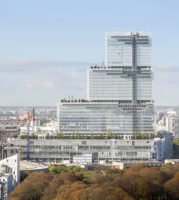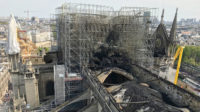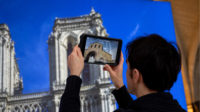Paris
When lighting designer Hervé Descottes began work on Jean Nouvel’s concert hall, the Philharmonie de Paris, the project was well under construction, and the architect even had another designer’s lighting scheme in hand.
“Jean Nouvel was very uncomfortable with [the other scheme],” says Descottes, whose firm, L’Observatoire International, is based in New York. “He didn’t think it would work.” Descottes, who collaborated with Nouvel on projects in Asia as well as his Guthrie Theater in Minneapolis, explains that the previous plan anchored the lighting to the ground and resulted in hot spots in mock-ups. Nouvel’s brief to Descottes was to create instead a feeling of complete levitation. “The challenge was like jumping into quicksand to try to save a friend,” says Descottes, laughing. “At the end, he was happy with it.”
That seems plausible, even though Nouvel famously distanced himself from the shimmering stainless-steel hall on the east side of the Parc de la Villette after numerous construction delays and allegations of cost overruns led to the hall’s opening uncompleted in January 2015. Nouvel didn’t attend the gala celebration and released a statement defending Ateliers Jean Nouvel, stating, in part: “Today, the Philharmonie de Paris opens. Too early. The building is not finished. There were no acoustic tests of the concert hall. The schedule did not allow the architectural and technical requirements to be respected. This despite all the warnings, which I have been giving since 2013.”
Nevertheless, the Philharmonie opened to rave reviews of its acoustics, orchestrated by Marshall Day, and of its 2,400-seat Grande Salle, with sinuous balconies and vineyard style tiers. Descottes matched the soft, round architecture—“there isn’t a single sharp corner”—with lighting that he described as perfectly uniform and diffuse. The custom LED luminaires, completely hidden in the architecture, go from a bright white to a lush amber, changing according to the event or dimming sequentially from the sides of the hall to the square central stage, “like a flower starting to open,” says Descottes. The stage lights above the musicians are crystalline in their clarity, by contrast.
The designer created shoebox-like containers—about a foot long by 8 inches wide—to contain 90 LEDs each (the hall has 641 fixtures in total). He then tucked most of these boxes behind the two levels of balconies and on top of the architect’s floating “clouds,” organically shaped acoustic panels that hang above the stage and seating. With the help of glass reflectors inside the boxes, the light bounces off the ceiling. The textured surface of some of the balcony fascia and wall panels helped hide any imperfections, says Descottes.
In the glowing yellow circulation space that surrounds the hall, Descottes designed angled, rectangular boxes, on top of which he placed LEDs that project light onto the walls and ceilings. The sculptural podiums don’t reveal the light source and, as in the concert hall, create an almost shadowless glow. “It was a little like a dance, because we had to work with what was existing,” says Descottes. He adds that projects in which the fixtures are hidden are becoming the norm for L’Observatoire, especially in Europe. Rather than designing decorative elements, Descottes is focused, as he was at the Philharmonie, on allowing the architecture to sing.
PeopleArchitect: Ateliers Jean Nouvel - Jean Nouvel, principal; David Letellier, Gregory Bismuth, project leaders
Lighting Design: L'Observatoire International - Hervé Descottes, principal
Associate Architects: Metra+Associates
Engineers: Iosis International, Aedis (structual); Marshall Day (acoustical)
Client: La Philharmonie de Paris
Size: 1.1 million cubic feet (concert hall); 75,000 square feet (surrounding corridor)
Cost: withheld
Completion Date: January 2015 |
ProductsLighting Secante (custom fixtures); LED ON (LEDs)
Controls Novelty Group
|









Post a comment to this article
Report Abusive Comment